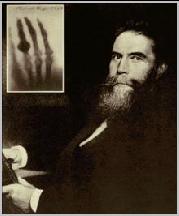

|
Wilhelm Conrad Röntgen: Father of the X-Ray |
In 1865, however, he entered the Federal Polytechnic Institute in Zurich by passing its examinations and he studied mechanical engineering. He ended up graduating from the University of Zurich with a Ph.D. in 1869. Röntgen taught for a time at Strasbourg University and then became a professor at the Academy of Agriculture in Württemberg.
He returned to Strasbourg to teach physics in 1876, and was appointed to chair physics at the University of Giessen in 1879, and at the University of Würzburg in 1888. In November of 1895, after numerous experiments and copious notes, following weeks of eating and sleeping in his laboratory, he discovered new rays he temporarily termed X-rays, later known as Röntgen Rays. Nearly two weeks after his discovery, he took his very first x-ray picture of his wife’s hand.
When she saw her skeleton she cried “I have seen my death!” Röntgen’s paper on the discovery was published 50 days later on December 28, 1895. Röntgen was awarded an honorary Doctor of Medicine degree from the University of Würzburg after his discovery. Today, Röntgen is considered the father of diagnostic radiology, Röntgen chaired at the University of Munich in 1900 and in 1901, he was awarded the very first Nobel Prize in Physics.
Röntgen donated the reward money from his Nobel Prize to his university. He later accepted an appointment at Columbia University in New York City and had even purchased his tickets, but World War One erupted, forcing him to change plans, and he spent the rest of his career in Munich. Röntgen died, nearly bankrupt, on 1923 from cancer of the intestine, probably as a result of his work. In accordance with his last wishes, all of his personal and scientific correspondence were destroyed upon his death. Röntgen refused to take out patents related to his discovery and did not even want the rays to be named after him.